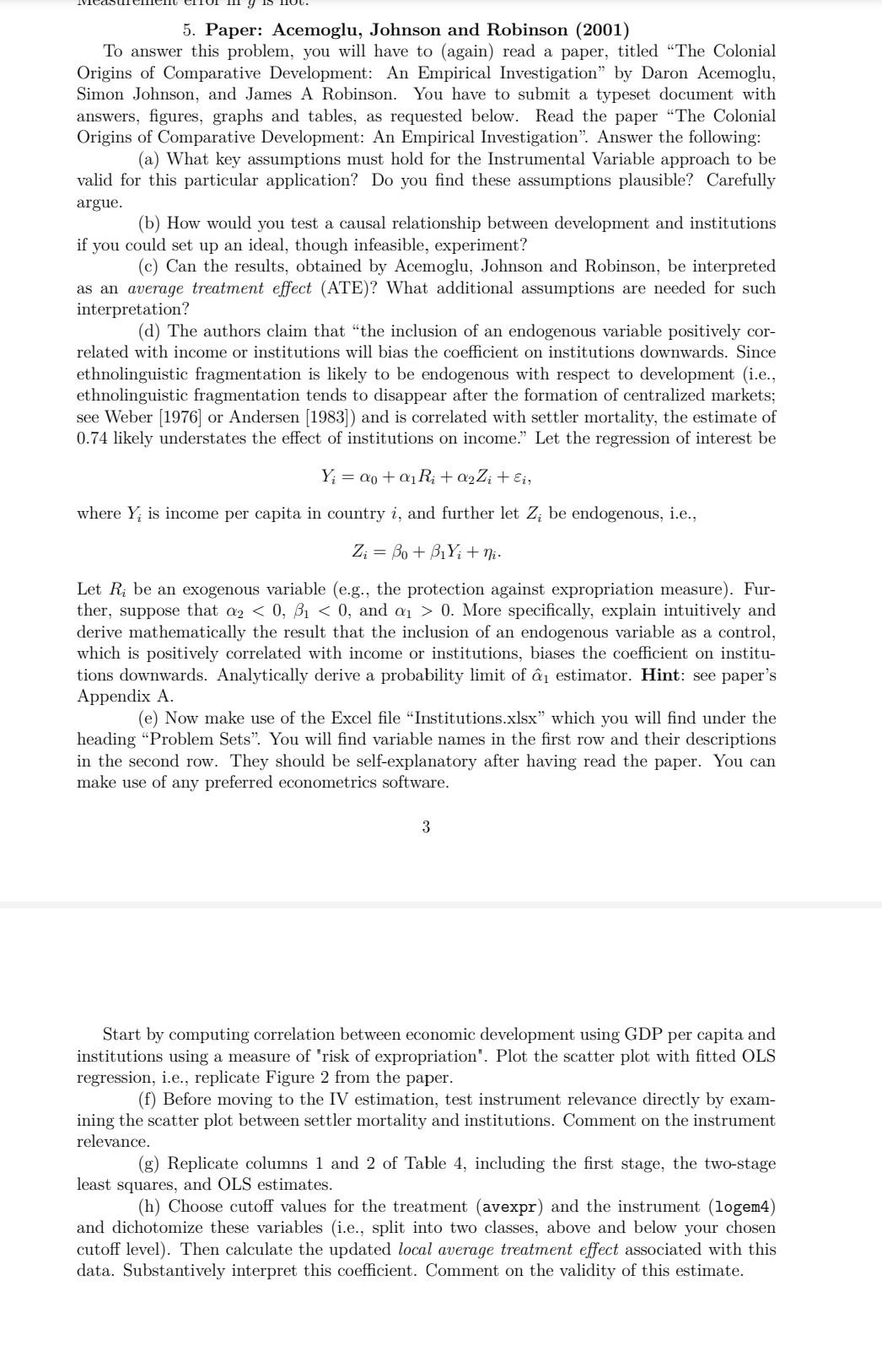Answered step by step
Verified Expert Solution
Question
1 Approved Answer
I can send you the reading by email, just tell me yours and I will send it 5. Paper: Acemoglu, Johnson and Robinson (2001) To

I can send you the reading by email, just tell me yours and I will send it
5. Paper: Acemoglu, Johnson and Robinson (2001) To answer this problem, you will have to (again) read a paper, titled "The Colonial Origins of Comparative Development: An Empirical Investigation" by Daron Acemoglu, Simon Johnson, and James A Robinson. You have to submit a typeset document with answers, figures, graphs and tables, as requested below. Read the paper The Colonial Origins of Comparative Development: An Empirical Investigation". Answer the following: (a) What key assumptions must hold for the Instrumental Variable approach to be valid for this particular application? Do you find these assumptions plausible? Carefully argue. (b) How would you test a causal relationship between development and institutions if you could set up an ideal, though infeasible, experiment? (c) Can the results, obtained by Acemoglu, Johnson and Robinson, be interpreted as an average treatment effect (ATE)? What additional assumptions are needed for such interpretation? (d) The authors claim that "the inclusion of an endogenous variable positively cor- related with income or institutions will bias the coefficient on institutions downwards. Since ethnolinguistic fragmentation is likely to be endogenous with respect to development (i.e., ethnolinguistic fragmentation tends to disappear after the formation of centralized markets; see Weber (1976) or Andersen (1983]) and is correlated with settler mortality, the estimate of 0.74 likely understates the effect of institutions on income." Let the regression of interest be Y; = do +QzR; +222 + Eis where Y, is income per capita in country i, and further let Z; be endogenous, i.e., Z; = Bo + BY + ni. Let Ri be an exogenous variable (e.g., the protection against expropriation measure). Fur- ther, suppose that a2 0. More specifically, explain intuitively and derive mathematically the result that the inclusion of an endogenous variable as a control, which is positively correlated with income or institutions, biases the coefficient on institu- tions downwards. Analytically derive a probability limit of estimator. Hint: see paper's Appendix A. (e) Now make use of the Excel file "Institutions.xlsx" which you will find under the heading "Problem Sets". You will find variable names in the first row and their descriptions in the second row. They should be self-explanatory after having read the paper. You can make use of any preferred econometrics software. 3 Start by computing correlation between economic development using GDP per capita and institutions using a measure of 'risk of expropriation". Plot the scatter plot with fitted OLS regression, i.e., replicate Figure 2 from the paper. (f) Before moving to the IV estimation, test instrument relevance directly by exam- ining the scatter plot between settler mortality and institutions. Comment on the instrument relevance. (g) Replicate columns 1 and 2 of Table 4, including the first stage, the two-stage least squares, and OLS estimates. (h) Choose cutoff values for the treatment (avexpr) and the instrument (logem4) and dichotomize these variables (i.e., split into two classes, above and below your chosen cutoff level). Then calculate the updated local average treatment effect associated with this data. Substantively interpret this coefficient. Comment on the validity of this estimate. 5. Paper: Acemoglu, Johnson and Robinson (2001) To answer this problem, you will have to (again) read a paper, titled "The Colonial Origins of Comparative Development: An Empirical Investigation" by Daron Acemoglu, Simon Johnson, and James A Robinson. You have to submit a typeset document with answers, figures, graphs and tables, as requested below. Read the paper The Colonial Origins of Comparative Development: An Empirical Investigation". Answer the following: (a) What key assumptions must hold for the Instrumental Variable approach to be valid for this particular application? Do you find these assumptions plausible? Carefully argue. (b) How would you test a causal relationship between development and institutions if you could set up an ideal, though infeasible, experiment? (c) Can the results, obtained by Acemoglu, Johnson and Robinson, be interpreted as an average treatment effect (ATE)? What additional assumptions are needed for such interpretation? (d) The authors claim that "the inclusion of an endogenous variable positively cor- related with income or institutions will bias the coefficient on institutions downwards. Since ethnolinguistic fragmentation is likely to be endogenous with respect to development (i.e., ethnolinguistic fragmentation tends to disappear after the formation of centralized markets; see Weber (1976) or Andersen (1983]) and is correlated with settler mortality, the estimate of 0.74 likely understates the effect of institutions on income." Let the regression of interest be Y; = do +QzR; +222 + Eis where Y, is income per capita in country i, and further let Z; be endogenous, i.e., Z; = Bo + BY + ni. Let Ri be an exogenous variable (e.g., the protection against expropriation measure). Fur- ther, suppose that a2 0. More specifically, explain intuitively and derive mathematically the result that the inclusion of an endogenous variable as a control, which is positively correlated with income or institutions, biases the coefficient on institu- tions downwards. Analytically derive a probability limit of estimator. Hint: see paper's Appendix A. (e) Now make use of the Excel file "Institutions.xlsx" which you will find under the heading "Problem Sets". You will find variable names in the first row and their descriptions in the second row. They should be self-explanatory after having read the paper. You can make use of any preferred econometrics software. 3 Start by computing correlation between economic development using GDP per capita and institutions using a measure of 'risk of expropriation". Plot the scatter plot with fitted OLS regression, i.e., replicate Figure 2 from the paper. (f) Before moving to the IV estimation, test instrument relevance directly by exam- ining the scatter plot between settler mortality and institutions. Comment on the instrument relevance. (g) Replicate columns 1 and 2 of Table 4, including the first stage, the two-stage least squares, and OLS estimates. (h) Choose cutoff values for the treatment (avexpr) and the instrument (logem4) and dichotomize these variables (i.e., split into two classes, above and below your chosen cutoff level). Then calculate the updated local average treatment effect associated with this data. Substantively interpret this coefficient. Comment on the validity of this estimateStep by Step Solution
There are 3 Steps involved in it
Step: 1

Get Instant Access to Expert-Tailored Solutions
See step-by-step solutions with expert insights and AI powered tools for academic success
Step: 2

Step: 3

Ace Your Homework with AI
Get the answers you need in no time with our AI-driven, step-by-step assistance
Get Started


